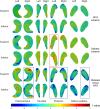Higher fasting plasma glucose is associated with striatal and hippocampal shape differences: the 2sweet project
- PMID: 27252872
- PMCID: PMC4885274
- DOI: 10.1136/bmjdrc-2015-000175
Higher fasting plasma glucose is associated with striatal and hippocampal shape differences: the 2sweet project
Abstract
Objective: Previous studies have demonstrated associations between higher normal fasting plasma glucose levels (NFG) (<6.1 mmol/L), type 2 diabetes (T2D) and hippocampal atrophy and other cerebral abnormalities. Little is known about the association between plasma glucose and the striatum despite sensorimotor deficits being implicated in T2D. This study aimed to investigate the relationship between plasma glucose levels and striatal and hippocampal morphology using vertex-based shape analysis.
Design: A population-based, cross-sectional study.
Setting: Canberra and Queanbeyan, Australia.
Participants: 287 cognitively healthy individuals (mean age 63 years, 132 female, 273 Caucasian) with (n=261) or without T2D (n=26), selected from 2551 participants taking part in the Personality & Total Health (PATH) Through Life study by availability of glucose data, MRI scan, and absence of gross brain abnormalities and cognitive impairment.
Outcome measures: Fasting plasma glucose was measured at first assessment, and MRI images were collected 8 years later. Shape differences indicating outward and inward deformation at the hippocampus and the striatum were examined with FMRIB Software Library-Integrated Registration and Segmentation Toolbox (FSL-FIRST) after controlling for sociodemographic and health variables.
Results: Higher plasma glucose was associated with shape differences indicating inward deformation, particularly at the caudate and putamen, among participants with NFG after controlling for age, sex, body mass index (BMI), hypertension, smoking and depressive symptoms. Those with T2D showed shape differences indicating inward deformation at the right hippocampus and bilateral striatum, but outward deformation at the left hippocampus, compared with participants with NFG.
Conclusions: These findings further emphasize the importance of early monitoring and management of plasma glucose levels, even within the normal range, as a risk factor for cerebral atrophy.
Keywords: Brain; Fasting Blood Glucose; MRI.
Figures

References
-
- Esposito K, Nappo F, Marfella R et al. . Inflammatory cytokine concentrations are acutely increased by hyperglycemia in humans: role of oxidative stress. Circulation 2002;106:2067–72. 10.1161/01.CIR.0000034509.14906.AE - DOI - PubMed
LinkOut - more resources
Full Text Sources
Other Literature Sources
